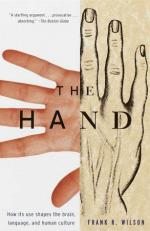
|
| Name: _________________________ | Period: ___________________ |
This test consists of 5 short answer questions, 10 short essay questions, and 1 (of 3) essay topics.
Short Answer Questions
1. How does Broca identify an area in the brain that controls speech?
2. What can both humans and primates make?
3. What do both knapping and rock climbing require?
4. What is Jack restoring?
5. To what does Kathleen Gibson attribute human intelligence?
Short Essay Questions
1. Who is Moshe Feldenkrais and what does he discover?
2. What does William Calvin believe about female apes?
3. Why does Wilson bring up his friend Jack Schaefer?
4. What must chefs do to create a meal?
5. Upon what does early medicine rely?
6. What is one of medicine's oldest links and how does it work?
7. Who is Patricia Greenfield and what does she theorize?
8. What is the title of Feldenkrais' book and what does the book claim?
9. Describe Peter Reynolds work.
10. How has the hand been used throughout its long history?
Essay Topics
Write an essay for ONE of the following topics:
Essay Topic 1
The Hand belongs to the non-fiction genre. Discuss the following:
1. Define the literary term "genre" and give several examples of three other genres in addition to the non-fiction genre.
2. Discuss two reasons why it might be useful to label a text by genre and two reasons it might be disadvantageous to label a text by genre.
3. What do you think is the difference between a non-fiction and a novel?
Essay Topic 2
Wilson has cited a number of people in this book. Discuss he following:
1. Choose three people whom Wilson mentions positively and give a brief idea of his opinions about those three people (or stereotypes). Use examples from The Hand to support your answer.
2. Choose three people whom Wilson mentions negatively and give a brief idea of his opinions about those three people (or stereotypes). Use examples from The Hand to support your answer.
3. Judging what Wilson says about different people in his text, how would you characterize him as a friend? As a colleague? Use examples from The Hand to support your answer.
Essay Topic 3
Wilson reflects on the notion that each of us evolve over time in our own lives by unifying body and spirit through personal growth and learning. For example, Percelly and David both cross paths of trouble and opportunity mixed with family and tribal routines to try new skills or combinations. These new-found abilities are part of their repertoire that becomes useful to them and can be passed on to others.
1. Explain why Wilson might believe that personal growth helps unite the spirit and the body. Use examples from the text to support your answer.
2. Discuss the ways in which having trouble in a person's life could be an opportunity. Use examples from the text to support your answer.
3. Discuss ways in which a person in a family or group or tribe learning new skills might benefit the entire group. Use examples from the text to support your answer.
|
This section contains 1,010 words (approx. 4 pages at 300 words per page) |

|




